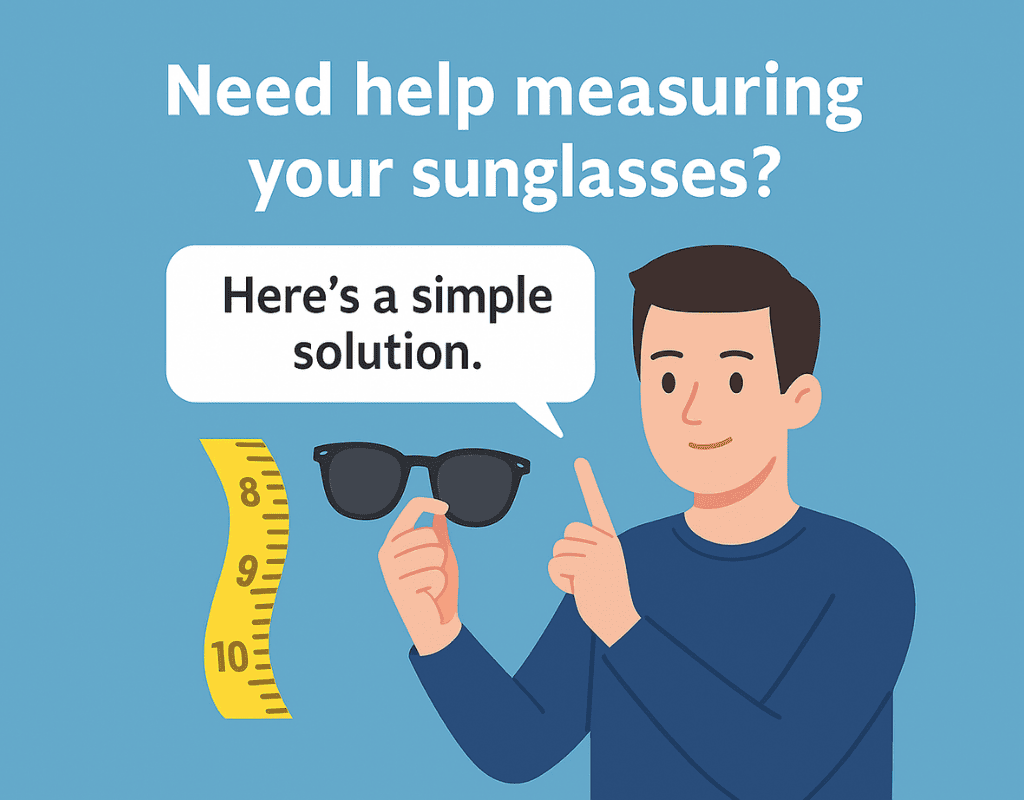Measuring sunglasses size correctly is crucial to ensuring comfort and proper fit. Whether you’re purchasing sunglasses for yourself or for clients in the B2B sector, understanding how to measure size can prevent discomfort and provide a better overall experience. In this guide, we’ll take you through the process of measuring sunglasses accurately, explain the importance of each measurement, and help you make informed decisions when selecting the right eyewear. Let’s dive into the essential steps and measurements you need to know for achieving the perfect fit.

1. Introduction to Measuring Sunglasses Size
When it comes to sunglasses, a proper fit is more than just a matter of aesthetics; it’s about comfort and function. The wrong size can lead to headaches, discomfort, and even damage to your eyewear. But here’s the kicker… finding the right size isn’t as simple as just guessing. In this article, we’ll show you exactly how to measure your sunglasses size, using the three key measurements: lens width, bridge width, and temple length. This information will not only enhance your buying experience but ensure that you never have to deal with ill-fitting sunglasses again.
The sunglasses industry has seen a shift toward custom-fit products, which is why understanding these measurements is crucial in both retail and wholesale contexts. By the end of this guide, you’ll have a thorough understanding of how to find the perfect pair of sunglasses that fits well and looks great.
2. Understanding Sunglasses Size Terminology
When you shop for sunglasses, you may encounter terms like “lens width,” “bridge width,” and “temple length.” What’s the real story? These are the fundamental measurements that determine whether your sunglasses will sit comfortably on your face. Let’s break down each term to ensure you know exactly what to look for.
Lens Width: This is the horizontal width of one lens. It’s the most important measurement when considering the overall size of the sunglasses. The average lens width ranges from 40mm to 60mm. A pair of lenses that are too wide may slide down your nose, while ones that are too narrow might feel too tight.
Bridge Width: This refers to the distance between the lenses, measured at the bridge of the nose. The bridge width typically ranges from 14mm to 24mm. Ready for the good part? This measurement is essential for comfort, as it affects how the sunglasses sit on your nose.
Temple Length: This is the length of the arms (or temples) of the sunglasses, from the hinge to the end tip. Most temples range from 120mm to 150mm. Here’s the deal… temple length affects how the sunglasses stay in place on your ears. If the temples are too short, the sunglasses may feel loose; if they’re too long, they may pinch behind your ears.
3. Tools You Need to Measure Sunglasses Size
Measuring sunglasses size is a simple process, but you’ll need the right tools. This is where it gets interesting… The basic tools required for sunglasses measurement are likely already in your home or office. To get the most accurate measurements, you’ll need either a measuring tape or a ruler.
A measuring tape is especially useful for measuring the bridge width and temple length, as it can easily conform to the shape of the frame. A ruler is effective for measuring the lens width, particularly if the sunglasses are flat or have a distinct shape.
Optional Tools: For precise measurements, especially if you’re creating custom sunglasses for clients, you may use calipers. This tool allows you to measure dimensions with greater accuracy and is ideal for professional eyewear manufacturers.
Let’s look at the tools you need and where to find them:
| Tool | Purpose | Where to Find It |
|---|---|---|
| Measuring Tape | Bridge and temple length | Available at home stores |
| Ruler | Lens width measurement | Available at office supplies |
| Calipers | High-precision measurements | Available online or at hardware stores |
4. How to Measure the Lens Width
Now that you have your tools, it’s time to measure the lens width. But here’s the kicker… You might think this step is obvious, but it requires precision to get it right. To measure the lens width, you need to measure the horizontal length of one lens at its widest point.
Place your ruler or measuring tape across the front of the lens from one side to the other. What’s the real story? Ensure the tape is parallel to the frame to get an accurate measurement. The standard lens width is typically between 50mm and 60mm, but this will vary depending on the style of the frame.
Common mistakes to avoid:
- Don’t measure at an angle. This can give inaccurate results.
- Make sure you measure across the lens only, not the entire frame.
- This is where it gets interesting… You can measure a pair of sunglasses that you already own to compare the lens width and ensure you get a similar fit with your next pair.
| Sunglasses Brand | Lens Width (mm) | Frame Type |
|---|---|---|
| Brand A | 54 | Round |
| Brand B | 56 | Aviator |
| Brand C | 58 | Oversized |
5. How to Measure the Bridge Width
Measuring the bridge width is essential for comfort. The bridge is the part that sits on your nose, so getting the right measurement is key to preventing discomfort and slippage. To measure the bridge width, use a measuring tape or ruler and place it across the space between the two lenses.
You might be wondering how tight or loose the bridge should be. Ready for the good part? If the bridge width is too wide, your sunglasses will sit too low on your nose. If it’s too tight, they’ll press against your nose, causing discomfort. The average bridge width falls between 14mm and 24mm.
To help you visualize, here’s a quick table comparing various bridge widths:
| Sunglasses Brand | Bridge Width (mm) | Best Fit For |
|---|---|---|
| Brand A | 18 | Medium faces |
| Brand B | 20 | Wide faces |
| Brand C | 22 | Narrow faces |
6. How to Measure the Temple Length
Finally, let’s move on to measuring the temple length. What’s the real story? The temples are the arms of your sunglasses that go behind your ears. If the temples are too short, your sunglasses will be uncomfortable, and they may fall off. If they’re too long, they might cause pinching or make the sunglasses feel unstable.
To measure the temple length, use a measuring tape or ruler and measure from the hinge to the end tip of the temple. Most sunglasses temples range from 120mm to 150mm. This is where it gets interesting… A well-fitting temple ensures that the sunglasses stay securely on your face without causing any discomfort.
| Sunglasses Brand | Temple Length (mm) | Best Fit For |
|---|---|---|
| Brand A | 135 | Average size |
| Brand B | 140 | Larger heads |
| Brand C | 145 | Small heads |
7. Understanding the Sunglasses Frame Size
Frame size refers to the overall dimensions of the sunglasses, including lens width, bridge width, and temple length. What’s the real story? The frame size determines how well the sunglasses fit on your face and whether they look proportionate to your features.
To choose the right frame size, combine all three measurements. If you find a pair of sunglasses with a 56mm lens width, 18mm bridge width, and 140mm temple length, this would typically fall into the medium size range. Sunglasses with larger dimensions, such as 60mm lens width and 22mm bridge, would be considered large size.
| Frame Size | Lens Width (mm) | Bridge Width (mm) | Temple Length (mm) |
|---|---|---|---|
| Small | 50-52 | 14-16 | 120-130 |
| Medium | 54-56 | 18-20 | 130-140 |
| Large | 58-60 | 20-22 | 140-150 |
8. How Sunglasses Fit: Comfort vs. Fashion
When selecting sunglasses, it’s important to balance comfort with fashion. You might be wondering how much the fit really matters when choosing a stylish pair. The truth is, comfort should never be compromised for the sake of fashion.
Comfortable sunglasses fit snugly but don’t press too hard on your temples or nose. Here’s the deal… If you’re constantly adjusting your sunglasses or feeling discomfort, you’ll likely avoid wearing them altogether. On the other hand, fashionable sunglasses can elevate your look, but only if they fit well. So when selecting eyewear, always check the fit before considering how stylish they are.
| Key Factor | Comfort | Fashion |
|---|---|---|
| Fit | Ensures all-day wear | Stylish look |
| Material | Lightweight and flexible | Trendy designs |
| Adjustability | Nose pads and temples adjustable | High-end materials |
9. How to Check if Sunglasses Fit Your Face Shape
Choosing sunglasses that complement your face shape is just as important as getting the measurements right. What’s the real story? Certain frames suit specific face shapes, and the right fit will enhance your overall appearance. For example, round sunglasses complement square faces, while angular frames are great for round faces.
To check if sunglasses fit your face shape, hold the sunglasses up to your face and see if they look proportional. Ready for the good part? If the sunglasses seem to overwhelm your features or look out of place, they may not be the right style for you.
| Face Shape | Best Frame Style |
|---|---|
| Round | Square, angular frames |
| Oval | Cat-eye, rectangular |
| Square | Round, aviator |
| Heart | Oval, butterfly |
10. Adjusting Sunglasses for a Better Fit
If your sunglasses don’t fit perfectly, don’t panic! What’s the real story? You can adjust your sunglasses to make them more comfortable. Small adjustments can go a long way, especially when it comes to temple length, nose pads, or even the frame width.
To adjust the nose pads, gently push them inwards or outwards until they rest comfortably on your nose. But here’s the kicker… If the temples are too tight or loose, you can carefully bend them for a better fit. Always make small adjustments to avoid damaging the frame. If you’re unsure, take your sunglasses to an optician for a professional fit.
| Adjustment | How to Adjust | Tool Needed |
|---|---|---|
| Nose Pads | Pinch to adjust | Pliers (optional) |
| Temples | Gently bend | Hands or pliers |
| Frame Width | Slightly adjust | Heat (for plastic frames) |
11. Measuring for Prescription Sunglasses
Prescription sunglasses require some extra attention when it comes to sizing. What’s the real story? In addition to the standard measurements, you also need to consider the thickness of the lenses and how they affect the fit. Prescription lenses may be thicker, requiring adjustments to ensure the sunglasses sit comfortably on your face.
It’s also important to check the lens curve and frame compatibility when selecting prescription sunglasses. Always consult with an optician to ensure that the sunglasses can accommodate the prescription lenses you require.
| Prescription Type | Lens Thickness (mm) | Recommended Fit |
|---|---|---|
| Standard | 2-4 | Regular size |
| High Prescription | 5+ | Larger frames |
12. Sunglasses Sizing for Kids and Teens
For children and teenagers, proper sizing is even more critical. What’s the real story? Kids’ faces are smaller, so sunglasses need to fit snugly without sliding off. Kids’ sunglasses often come with adjustable features to accommodate growing faces.
When choosing sunglasses for kids, measure their face size first. But here’s the kicker… If you’re unsure of your child’s size, choose a pair with adjustable temples and a flexible frame for a custom fit.
| Age Group | Lens Width (mm) | Bridge Width (mm) | Temple Length (mm) |
|---|---|---|---|
| Kids (4-7) | 45-50 | 14-16 | 110-120 |
| Teens (8-12) | 50-54 | 16-18 | 120-130 |
13. Common Mistakes When Measuring Sunglasses Size
Measuring sunglasses is straightforward, but there are common mistakes that can lead to inaccurate results. Here’s the deal… People often measure too quickly or overlook important details, such as the frame material or the curvature of the lens. These mistakes can lead to discomfort and poor fitting sunglasses.
To avoid these mistakes, always take the time to measure carefully. Ready for the good part? If you have a pair of sunglasses that fits well, use them as a reference for future purchases.
| Mistake | Description | How to Avoid |
|---|---|---|
| Incorrect Lens Width | Measuring diagonally instead of horizontally | Use a ruler across the lens |
| Overlooking Bridge Width | Not adjusting the bridge for comfort | Measure from the inner edge of the lenses |
| Ignoring Temple Length | Not considering the length behind the ears | Measure carefully from hinge to end tip |
14. Where to Find the Right Sunglasses for Your Size
Now that you know how to measure sunglasses size, it’s time to find the perfect pair. But here’s the kicker… You don’t have to rely on trial and error. Many online stores and retailers provide detailed size charts that make it easier to choose the right fit.
Here’s the deal… Many brands now offer custom sizes or adjustable frames, so you can get the perfect fit based on your measurements.
| Online Retailer | Sunglasses Fit Options | Customizable Frames |
|---|---|---|
| Brand A | Size charts available | Yes |
| Brand B | Filters for face shape | No |
| Brand C | Adjustable temples | Yes |
15. Conclusion: Ensuring a Perfect Fit Every Time
To sum up, measuring sunglasses size isn’t difficult once you understand the key measurements. Ready for the good part? Armed with the right tools and knowledge, you can confidently choose the perfect pair of sunglasses every time. Whether you’re shopping for yourself or for clients, understanding how to measure sunglasses ensures that you won’t have to deal with poor-fitting eyewear.
If you’re still unsure, consult with an optician for professional advice or measurements. With the right fit, your sunglasses will look great and stay comfortable throughout the day.
FAQ Section
Q1: What is sunglasses size?
A1: Sunglasses size refers to the measurements of the lenses, bridge, and temples, determining how well they fit your face.
Q2: How does sunglasses sizing work?
A2: Sunglasses sizing is based on three key measurements: the lens width, bridge width, and temple length. These measurements determine comfort and fit.
Q3: How do I know if my sunglasses fit correctly?
A3: Properly fitting sunglasses should rest comfortably on your nose and ears, without slipping or causing discomfort.
Q4: Can I adjust sunglasses if they’re too tight or too loose?
A4: Yes, many sunglasses can be adjusted by bending the temples or adjusting the nose pads for a better fit.
Q5: How do I measure sunglasses for my child?
A5: Measure your child’s face and choose sunglasses with adjustable temples and flexible frames to ensure a comfortable and secure fit.

